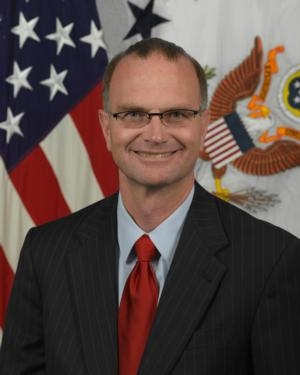Fri, Jun 08, 2012
U.S. Has 'Fine-Tuned' Methods To Promote Responsible Use Of Space
The U.S. has fine-tuned its methods to promote responsible use of space and strengthen international partnerships, Ambassador Gregory L. Schulte, the deputy assistant secretary of defense for space policy, said during the 2012 Women in Aerospace Conference June 1. In his keynote address at the conference, Schulte outlined the plan to protect U.S. advantages and sustainability in space as directed by the National Security Strategy for Space issued by Defense Secretary Leon E. Panetta and national intelligence officials.

"Space is no longer a pristine environment," Schulte (pictured) said. "We have to think differently about how we cooperate with others in space."
Schulte explained that burgeoning interest in space by a number of nations is both an asset and a liability. "Allied capabilities can augment ours, add resilience and increase our ability to operate in a contested space environment when adversaries may be trying to take away our space capabilities," he said. "As there are more and more actors in space, it becomes more important that we bring a certain amount of order to that domain, that we encourage countries to act responsibly." As such, Schulte said, Secretary of State Hillary Rodham Clinton and U.S. Strategic Command, based at Offutt Air Force Base, Neb., have weighed in this year to take deliberate steps in negotiating space situational awareness agreements with countries across the globe.
The discussions have united the "European Union and other space-faring countries to develop an international voluntary code of conduct meant to encourage countries to act responsibly and call out those who act irresponsibly," Schulte said.
The norms, Schulte asserts, aim to help U.S. and coalition countries share information on an emergency basis, encourage best practices to buffer the uptick of mishaps and control the creation of additional debris in space. "(STRATCOM) tracks over 20,000 pieces of debris -- and that's just what they can see," Schulte said. "NASA estimates there are probably hundreds of thousands of pieces of debris up there."
Harnessing international partnerships also includes a plan to expand the Joint Space Operations Center at Vandenberg Air Force Base, Calif., into a coalition asset by integrating Canada's first operational military space-based telescope system, Sapphire. A larger constellation of satellites supplied by international partner nations provides greater coverage and bandwidth, Schulte said, and also creates an international space alliance that can act as a deterrent to threats against the U.S. and its allies.
More News
Aero Linx: International Federation of Airworthiness (IFA) We aim to be the most internationally respected independent authority on the subject of Airworthiness. IFA uniquely combi>[...]
Ultrahigh Frequency (UHF) The frequency band between 300 and 3,000 MHz. The bank of radio frequencies used for military air/ground voice communications. In some instances this may >[...]
A Few Questions AND Answers To Help You Get MORE Out of ANN! 1) I forgot my password. How do I find it? 1) Easy... click here and give us your e-mail address--we'll send it to you >[...]
From 2019 (YouTube Edition): Learning To Paint Without Getting Any On Your Hands PPG's Aerospace Coatings Academy is a tool designed to teach everything one needs to know about all>[...]
Also: Sustainable Aircraft Test Put Aside, More Falcon 9 Ops, Wyoming ANG Rescue, Oreo Cookie Into Orbit Joby Aviation has reason to celebrate, recently completing its first full t>[...]
 ANN's Daily Aero-Linx (05.06.25)
ANN's Daily Aero-Linx (05.06.25) ANN's Daily Aero-Term (05.06.25): Ultrahigh Frequency (UHF)
ANN's Daily Aero-Term (05.06.25): Ultrahigh Frequency (UHF) ANN FAQ: Q&A 101
ANN FAQ: Q&A 101 Classic Aero-TV: Virtual Reality Painting--PPG Leverages Technology for Training
Classic Aero-TV: Virtual Reality Painting--PPG Leverages Technology for Training Airborne 05.02.25: Joby Crewed Milestone, Diamond Club, Canadian Pilot Insurance
Airborne 05.02.25: Joby Crewed Milestone, Diamond Club, Canadian Pilot Insurance



